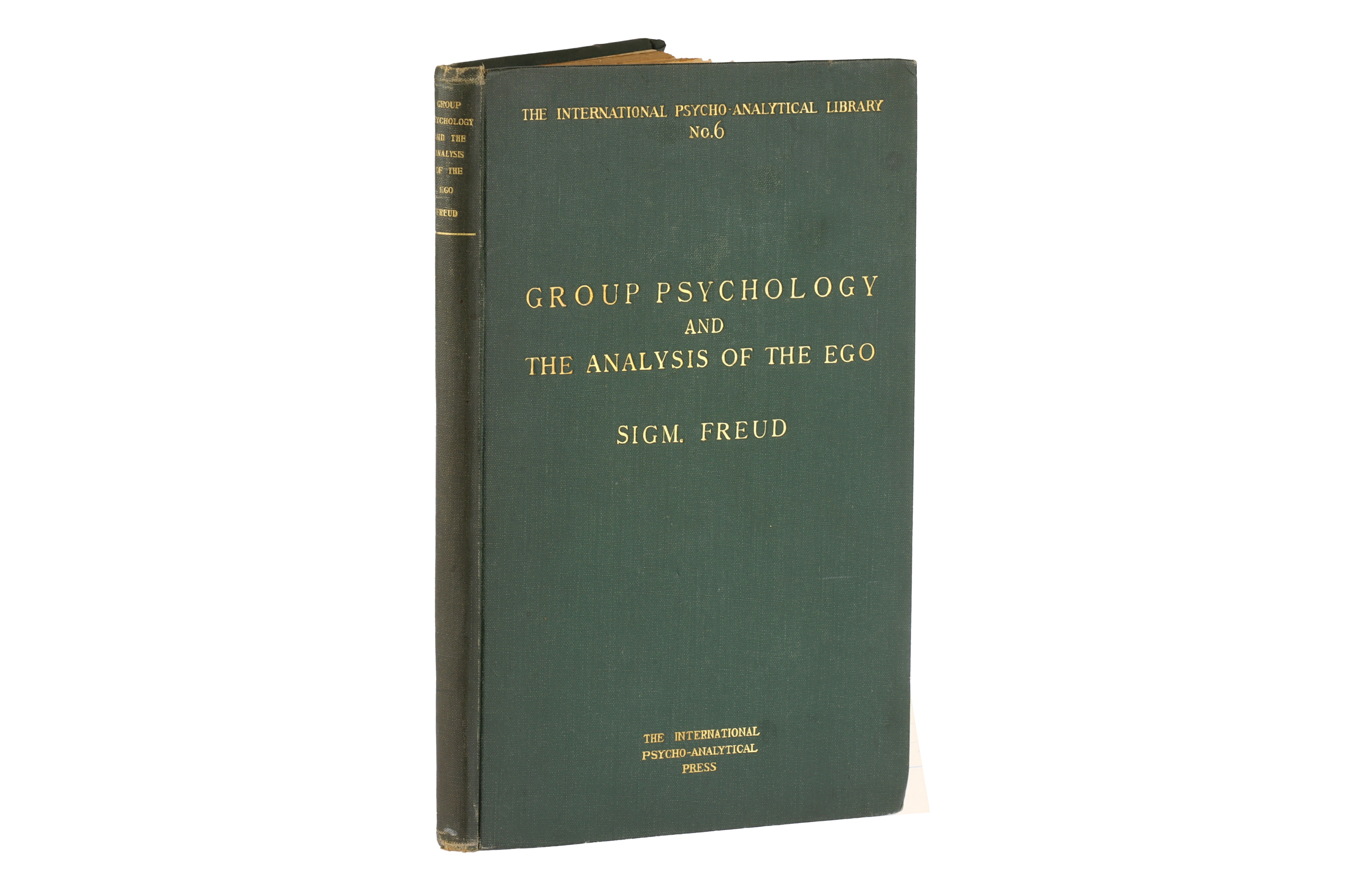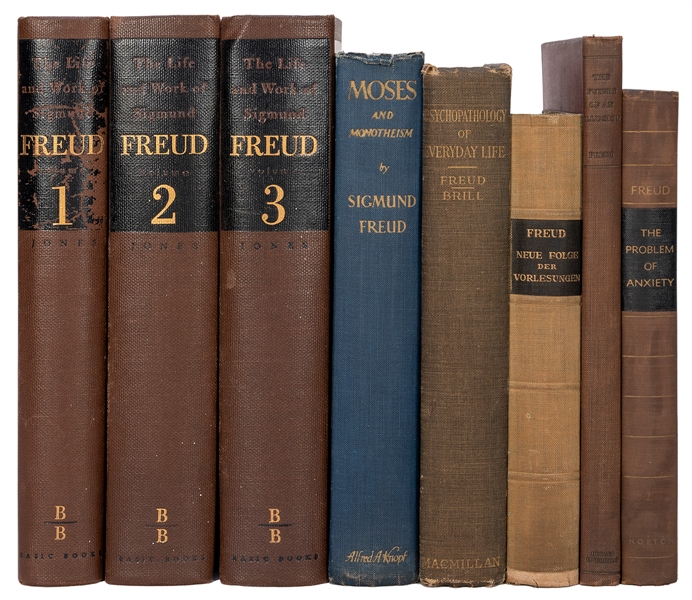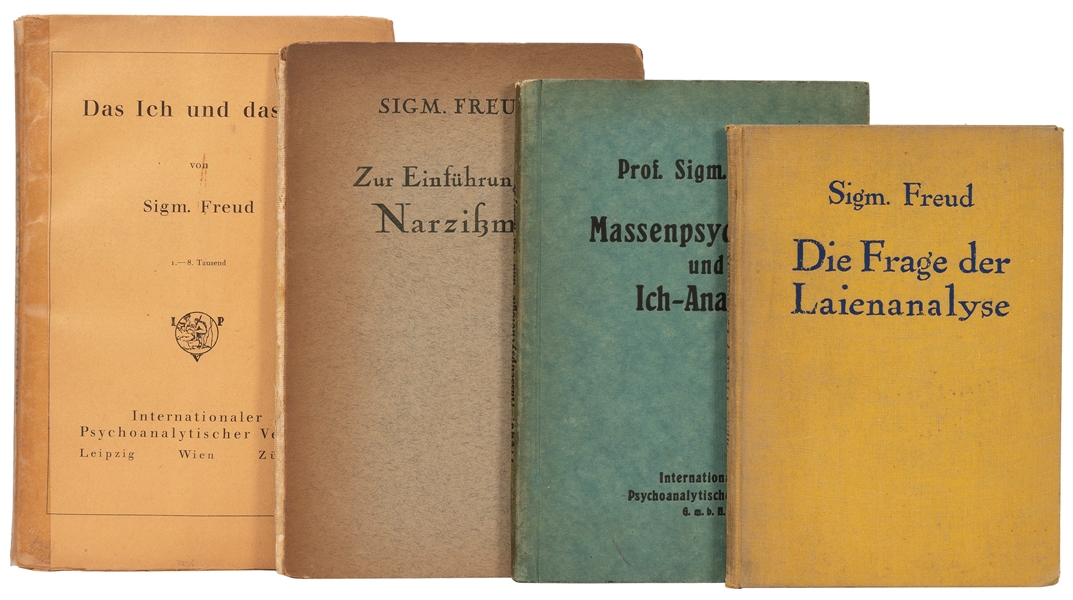FREUD, SIGMUND. A group of 48 letters and 3 telegrams to his nephew Edward L. Bernays in New York (comprising 23 autograph letters signed, 18 typed letters signed and 7 autograph postcards signed), [Vienna], September 1919 - May 1931, together 79 pages, 8vo-4to, on Freud's personal printed stationery, with 9 envelopes addressed by Freud, two letters (20 July 1920 and 4 Feb. 1921) with signatures cut away, a few short fold tears or marginal tears, occasional minor staining , in German and English; with xeroxed copies of Bernays's letters to Freud; and with two typed letters signed ("Doppelkusine Anna" and "Dpl. Anna") from Anna Freud, 22 and 24 July 1925, 3 pages, 4to , in German. BRINGING FREUDIAN PSYCHOANALISIS TO AMERICA Edward Bernays, Freud's nephew by marriage, had moved to the United States with his family [when still a child]. His pioneering work in advertising and ...; and he is generally considered the founder of the public-relations industry. This extensive correspondence principally concerns the publication of Freud's Introductory Lectures on Psychoanalysis , the first book of Freud's to be published in the United States, and Bernays's related efforts to promote the understanding of Freudian psychoanalysis in this country. As such they throw light on Freud's attitudes toward publication and toward the popularization of his works, toward money in general and toward Americans, while documenting his sometimes rather confused grasp of publishing rights, and contrastingly careful attention to the problems of translation. They also trace the evolution of an exchange that began somewhat formally and with a tinge of mistrust or irritation from the older man, soon however overcome by affectionate respect and finally immense gratitude for Bernays's indefatigable and selfless efforts to make his uncle's work more widely known. In July 1919, having opened an office in New York, Bernays proposed to Horace Liveright of Boni and Liveright that they publish a translation of Freud's Vorlesungen zur Entführung in die Psychanalyse , a series of lectures delivered at the University of Vienna in the winters of 1916 and 1917. As Bernays explains in his Biography of an Idea ( ) his aims were twofold: to earn extra money for Freud - although it was not until years later that Bernays learned of the gravity of the latter's financial difficulties during those years of accelerating inflation - and to dispel popular misconceptions of psychoanalysis while encouraging a growing interest in the new discipline. From the start Bernays acted wholly without recompense, and in spite of the considerable demands made on his time and patience during the first few years of his role as Freud's unofficial agent, every penny of the royalties was sent directly to his uncle. Boni and Liveright subsequently published several other books by Freud. Freud's telegrammed consent to the project (not included in this correspondence) was subsequently qualified, in the first of the present letters, dated 27 September 1919, and even temporarily retracted in a telegram of 6 October; but these qualms were largely based on misunderstandings concerning the publishing rights and the projected form of publication, and Bernays quickly allayed them by sending his uncle an itemized description of projected expenses and income along with advance of $100. He had obtained for Freud a 15 royalty for this first edition of 3000 copies sold for $4 a copy. Many editions followed, for this proved the most accessible of Freud's works for the layman; translated into over 15 languages and equally successful in Germany and abroad, it became, as its author flatly stated six years after its first publication, "the only book which pays" (14 September 1923). Freud's initial scruples concerning the publication of the lectures touch upon a recurring theme in his letters to his expatriate nephew, that is, his uncomprehending disdain for the "American way": "I heard from Mr. Hirsch that your i
FREUD, SIGMUND. A group of 48 letters and 3 telegrams to his nephew Edward L. Bernays in New York (comprising 23 autograph letters signed, 18 typed letters signed and 7 autograph postcards signed), [Vienna], September 1919 - May 1931, together 79 pages, 8vo-4to, on Freud's personal printed stationery, with 9 envelopes addressed by Freud, two letters (20 July 1920 and 4 Feb. 1921) with signatures cut away, a few short fold tears or marginal tears, occasional minor staining , in German and English; with xeroxed copies of Bernays's letters to Freud; and with two typed letters signed ("Doppelkusine Anna" and "Dpl. Anna") from Anna Freud, 22 and 24 July 1925, 3 pages, 4to , in German. BRINGING FREUDIAN PSYCHOANALISIS TO AMERICA Edward Bernays, Freud's nephew by marriage, had moved to the United States with his family [when still a child]. His pioneering work in advertising and ...; and he is generally considered the founder of the public-relations industry. This extensive correspondence principally concerns the publication of Freud's Introductory Lectures on Psychoanalysis , the first book of Freud's to be published in the United States, and Bernays's related efforts to promote the understanding of Freudian psychoanalysis in this country. As such they throw light on Freud's attitudes toward publication and toward the popularization of his works, toward money in general and toward Americans, while documenting his sometimes rather confused grasp of publishing rights, and contrastingly careful attention to the problems of translation. They also trace the evolution of an exchange that began somewhat formally and with a tinge of mistrust or irritation from the older man, soon however overcome by affectionate respect and finally immense gratitude for Bernays's indefatigable and selfless efforts to make his uncle's work more widely known. In July 1919, having opened an office in New York, Bernays proposed to Horace Liveright of Boni and Liveright that they publish a translation of Freud's Vorlesungen zur Entführung in die Psychanalyse , a series of lectures delivered at the University of Vienna in the winters of 1916 and 1917. As Bernays explains in his Biography of an Idea ( ) his aims were twofold: to earn extra money for Freud - although it was not until years later that Bernays learned of the gravity of the latter's financial difficulties during those years of accelerating inflation - and to dispel popular misconceptions of psychoanalysis while encouraging a growing interest in the new discipline. From the start Bernays acted wholly without recompense, and in spite of the considerable demands made on his time and patience during the first few years of his role as Freud's unofficial agent, every penny of the royalties was sent directly to his uncle. Boni and Liveright subsequently published several other books by Freud. Freud's telegrammed consent to the project (not included in this correspondence) was subsequently qualified, in the first of the present letters, dated 27 September 1919, and even temporarily retracted in a telegram of 6 October; but these qualms were largely based on misunderstandings concerning the publishing rights and the projected form of publication, and Bernays quickly allayed them by sending his uncle an itemized description of projected expenses and income along with advance of $100. He had obtained for Freud a 15 royalty for this first edition of 3000 copies sold for $4 a copy. Many editions followed, for this proved the most accessible of Freud's works for the layman; translated into over 15 languages and equally successful in Germany and abroad, it became, as its author flatly stated six years after its first publication, "the only book which pays" (14 September 1923). Freud's initial scruples concerning the publication of the lectures touch upon a recurring theme in his letters to his expatriate nephew, that is, his uncomprehending disdain for the "American way": "I heard from Mr. Hirsch that your i



.jpg)
.jpg)








.jpg)

Testen Sie LotSearch und seine Premium-Features 7 Tage - ohne Kosten!
Lassen Sie sich automatisch über neue Objekte in kommenden Auktionen benachrichtigen.
Suchauftrag anlegen